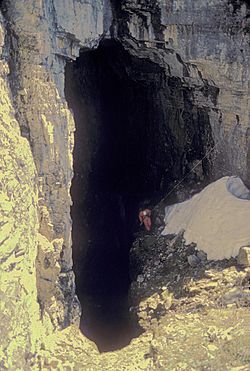Close to the Edge (cave) facts for kids
Quick facts for kids Close to the Edge |
|
|---|---|

Entrance to CTTE, 1986
|
|
| Location | Close To The Edge Provincial Park, British Columbia, Canada |
| Depth | 472 metres (1,549 ft) |
| Length | 967 metres (3,173 ft) |
| Discovery | 1985 |
| Entrances | 1 |
| Difficulty | Highly technical |
| Hazards | Ice |
Close to the Edge is a really important cave located in the Dezaiko Range of the Rocky Mountains in British Columbia, Canada. It's found inside the Close To The Edge Provincial Park and Protected Area, about 160 kilometers (100 miles) east of Prince George, British Columbia. This cave is known for being very deep and challenging to explore!
Why is it Called Close to the Edge?
The cave got its name for a couple of cool reasons. First, it's right on the edge of a huge cliff! When you stand at the entrance, you can look down a 255-meter (836-foot) deep shaft on one side. On the other side, there's a 700-meter (2,300-foot) drop to the valley floor.
This amazing location also reminded people of the artwork on a 1972 music album. It was called Close to the Edge by the band Yes. That album cover showed lakes that looked like they were impossibly perched on mountain tops.
Finally, the cavers (people who explore caves) who first explored it felt like they were pushing their limits. They were "close to the edge" of what they could do while exploring such a deep and difficult cave.
What is the Cave Like Inside?
The entrance to Close to the Edge is about 20 meters (65 feet) wide. It's located in a cliff near the top of an unnamed mountain. You can't easily see it from the ground because a natural rock wall hides it. It's only visible from the air!
The cave starts with an incredibly deep entrance shaft. This first drop is 255 meters (836 feet) deep, making it the deepest single shaft in all of Canada! Often, a giant icicle, about 20 meters (65 feet) long, hangs down inside it.
After this first huge drop, there are many more shafts, though they are not as deep. These include drops of 32 m, 17 m, 7 m, 10 m, 10 m, 8 m, 9 m, 68 m, and 9 m. The cave ends at a sump, which is a passage filled with water.
Even though the total length of all the passages is 967 meters (3,172 feet), the cave's overall depth is 472 meters (1,548 feet). This makes Close to the Edge the fourth-deepest cave in Canada. Scientists believe the water from the sump eventually comes out at a place called Twin Falls Resurgence, about 600 meters (1,968 feet) below the cave entrance.
How Was the Cave Explored?
The first time anyone officially saw the entrance to Close to the Edge was in 1985. Cavers spotted it from a helicopter while they were helping with another expedition nearby.
The very next year, in 1986, explorers went into the cave. They reached a blockage made of frozen mud and stones at the bottom of the second big drop, at a depth of 263 meters (862 feet).
It took several years, but in 1994, a team led by Neeld Messler, Jim Hewett, and Stephen Alvarez managed to remove this blockage. This opened up more of the cave for exploration.
The final major exploration happened in 2001. A team led by Canadians John Donovan, Jason Morgan, Dan Pach, and Australian Warwick M Green (also known as Warwick Baggs) pushed past the old blockage. They discovered the sump at the deepest point of 472 meters (1,548 feet). This team also carefully measured and mapped the entire cave. They shared their findings with the help of Dr. Chas Young from the University of Calgary.

